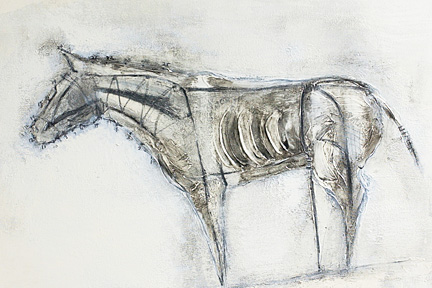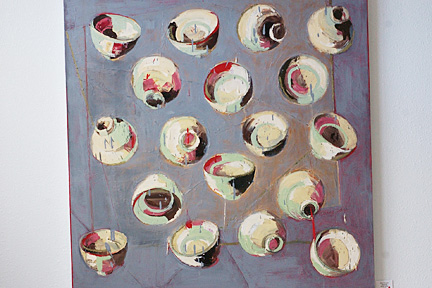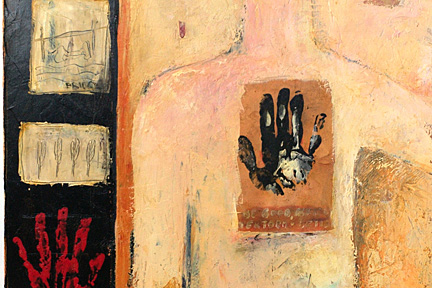
Artists Elisabeth Knoke-Dieckvoss, left, Deborah Nehmad, Kloe Kang and Jodi Endicott, gathered at Endicott's Balcony Gallery in Kailua, find support in sharing their work and their goals.
Shared perspectives
Female artists band together
for much-needed support
English novelist Virginia Woolf famously declared in 1922 that what women need to create is an independent income and a "room of one's own." And we do usually think of the creative genius working alone, freed from the demands and distractions of family and society.
Kailua Second Sunday Gallery WalkWhere: Start at The Balcony Gallery, 442-A Uluniu St.; pick up information on about 11 other participants.When: 2 to 5 p.m. today Admission: Free Call: 263-4434 Also: Art sale proceeds at Balcony will go to Red Cross Hurricane Katrina Relief Fund
|
"When you're working in your own studio, you're too close to your work -- you have no perspective," said Deborah Nehmad. "I really need people."
Nehmad is one of a half-dozen female artists who have discovered that an income and a studio alone do not an artist make.
She and three other recent graduates from the master of fine arts program at the University of Hawaii joined a handful of other women to form a critique group in 1998.
Their reasons, at first, were not entirely clear. But when the women came together recently to talk about their summer reunion exhibit, which just ended at the Balcony Gallery in Kailua, what they remembered was how much they all wanted to succeed. Not to sell art, necessarily, and certainly not to make a living at it, but to make good art -- the kind that gets taken seriously, the kind Virginia Woolf was writing about and created herself.
"I was always taught in graduate school that you can't make art that looks good, you have to make art that means something," Nehmad said. As art students, that standard was hammered home in critique, group evaluations of one's work that are the crucible of art students everywhere. Out in the world, however, the beginning artist soon finds that financial success usually means making pleasant, decorative work that won't clash with the sofa.
"We used to hate critique and want to kill everyone afterward," painter Kloe Kang said with a laugh, "but after a while you came out (of school), and you talk to your husband and friends ... they don't really care about art."

Before long, you get desperate for someone to talk to, the women said -- someone who understands your floundering without the direction, deadlines and dogma of school. It's too easy to just quit.
Within a year or two of graduating, painter and sculptor Endicott, printmaker Nehmad and painters Kang, Nadine Ferraro and Elisabeth Knoke-Dieckvoss started getting together with established artists Laura Smith, Nancy Poes and Tsugumi Iwasaki-Higbee for monthly bouts of constructive criticism.
With the agony of academic critique still vivid in their minds, they were almost "too nice" to help each other at first, Nehmad recalled. "We still got caught in not being able to be completely honest about what we felt."
Sessions often began with "I like this" or "I don't like that" -- not much more useful than hearing from family and friends, Kang said.
It took some time to develop an eye for each other's early efforts, to see the work evolve, to spot something fresh and find a tactful way to encourage it. "Sometimes it's hard because it's not necessarily my style, but I can't critique what I don't like," Knoke-Dieckvoss said. "Knowing you as an artist, and maybe finding out what you like -- it's a fine line."

Endicott, who had been painting and drawing horses for years, remembers when Ferraro said she didn't respond to the horse drawings, and would rather see some carry-over from Endicott's sculptural work.
"I was like, 'What do you mean?!'" said Endicott, who sells and shows her paintings and creates sculptures on public commission today. "But eventually you process that. It might take a while to think about what does that mean, what is that person seeing? But that was when I started drawing things like a sculpture."
Her recent drawings -- a return to the horse after years of staying away from the subject -- reveal the animal's skeletal armature, while her paintings contain found objects in recessed, three-dimensional spaces.
In most cases it's not so much the specifics of such suggestions that stand out in the women's minds today.
"It's the dialogue," Nehmad said. "It was talking about what I was interested in."
They shared information on everything from upcoming competitions to how to fit the long titles of artwork onto the tiny edges of slides. They commiserated or celebrated little successes -- and in those days they were little, before there were many places to sell or show art in Hawaii, before First Friday and other venues served the growing vision of the islands as a cultural commodity with advertising potential.

One day, though, it happens. The women agree on this: If you persist, eventually you find your voice, your vision, and you know what you have to do. In the absence of external rewards, it is the first sign that you are about to reach the next level.
"You don't want to eat, you don't want to go to the bathroom and that's all you can think about," Endicott said. "You're driving around and thinking about this piece that you're working on."
Their work testifies to the natural evolution. Ferraro, who left school obsessively painting lemons as a vehicle to master painting, has moved on to abstract, geometric works and emotive brushwork from which the lemons have all but disappeared.
Knoke-Dieckvoss said she spent years obsessed with texture, layering paint, until she realized recently that she had lost expression. On a recent canvas, the fussy brushwork and self-conscious color of early efforts have yielded to serve an organic, dreamy vision.

And Nehmad, whose trademark is obsessive burning of numbers into yards of paper, has lately made this pyrography just the melody in a symphony of color, surface and form.
Their critique meetings petered out as members were drawn off by their obsessive vision -- or the many things in life that come along to cloud it.
But they have seen their efforts pay off in another way, as collaborative spirit led several of them to actively promote venues such as Chinatown, First Friday and the new Balcony Gallery itself, owned jointly by Endicott, gallery manager Linda von Geldern and attorney Libby Tomar.
Endicott is especially boosterish on the rewards of artists working in a cooperative, rather than a competitive, model -- which historically has been the creative style of women, from craft huis to sewing bees.
Not a room of one's own, in other words, but a home for the artist and her artwork.
The most important thing about those meetings was being among kindred spirits, recalled Knoke-Dieckvoss, whose job and daily life have little to do with art. "For me it's just, 'My God, they know who I am, that I'm an artist -- they know who I am.' So it's feeling comfortable, feeling at home. They understand. And I really miss that."
E-mail to Features Desk
[News] [Business] [Features] [Sports] [Editorial] [Do It Electric!]
[Classified Ads] [Search] [Subscribe] [Info] [Letter to Editor]
[Feedback]
